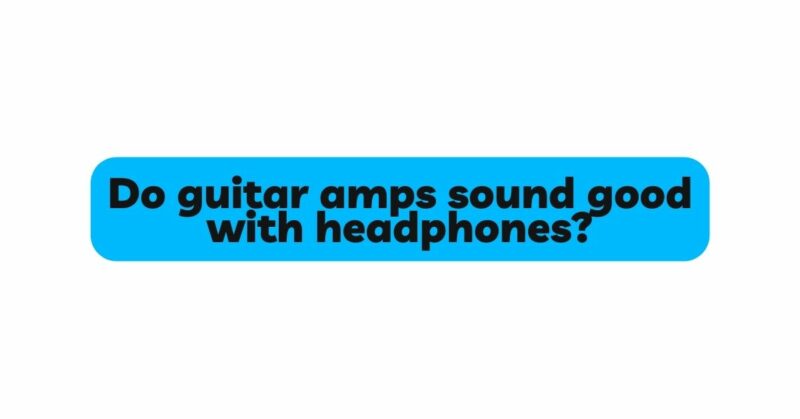Guitar amplifiers are iconic tools that shape the sound and character of the electric guitar. Traditionally, guitarists rely on amplifiers and speaker cabinets to project their instrument’s tones. However, there are situations where using headphones with guitar amps can be beneficial. Whether for silent practice, late-night jamming, or recording in a noise-sensitive environment, headphones offer a unique way to experience the tonal qualities and versatility of guitar amps. In this article, we will delve into the world of guitar amps with headphones, exploring the benefits, considerations, and techniques involved.
- Benefits of Using Headphones with Guitar Amps:
a. Silent Practice: Using headphones with guitar amps allows for silent practice sessions without disturbing others. It provides an opportunity to practice anytime, anywhere, without compromising on tone and expressive playing.
b. Personal Listening Environment: Headphones create a focused and immersive listening environment, allowing guitarists to concentrate on nuances, dynamics, and intricate details of their playing. This enhances the overall playing experience and facilitates skill development.
c. Noise Isolation: Headphones isolate the guitar’s sound directly into your ears, minimizing external noise and distractions. This enables guitarists to hear the full spectrum of their amp’s tone without interference from ambient noise.
d. Versatility and Portability: Headphones offer the flexibility to use guitar amps in various environments, including home studios, apartments, or while on the go. This versatility enables guitarists to enjoy their amplified tone without limitations.
- Understanding the Headphone and Guitar Amp Connection:
a. Using Headphone Outputs: Many modern guitar amps come equipped with dedicated headphone outputs. These outputs typically have built-in speaker simulation and impedance matching to optimize the sound for headphone listening. They provide a direct connection to your headphones, ensuring a seamless integration.
b. Audio Interfaces: If your guitar amp does not have a dedicated headphone output, you can connect it to an audio interface with a headphone output. The audio interface allows you to capture the amp’s signal and monitor it through headphones while providing additional recording and mixing capabilities.
- Choosing the Right Headphones:
a. Closed-Back vs. Open-Back: Closed-back headphones provide better sound isolation and prevent sound leakage, making them ideal for private practice and recording. Open-back headphones offer a more natural and spacious sound but may not provide the same level of isolation.
b. Frequency Response and Sound Signature: Look for headphones with a balanced frequency response that accurately reproduces the guitar amp’s tone. Consider headphones with a neutral sound signature to ensure an accurate representation of your amp’s characteristics.
c. Comfort and Fit: Opt for headphones that are comfortable to wear for extended periods. Over-ear headphones are often preferred for their comfort and better sound isolation, while in-ear monitors (IEMs) offer portability and a snug fit.
- Simulating Speaker Response:
a. Built-in Speaker Emulation: Many guitar amps with headphone outputs include built-in speaker emulation technology. This simulates the sound and response of various speaker cabinets, allowing you to experience the amp’s tone as if it were played through a physical speaker.
b. Impulse Responses (IRs): Impulse responses are digital snapshots of real speaker cabinets and microphones. By using IRs with headphone amp simulators or software plugins, you can further enhance the authenticity and realism of your amp’s sound.
- Techniques and Considerations:
a. Playing Dynamics: When using headphones with guitar amps, pay close attention to your playing dynamics. With the absence of natural room resonance, dynamics become crucial for expressing your musicality and ensuring a balanced and nuanced sound.
b. Volume and Ear Protection: While headphones provide an immersive listening experience, it is essential to monitor the volume levels to prevent ear fatigue and potential hearing damage. Maintain a moderate and comfortable listening level to ensure a safe and enjoyable experience.
c. Adjusting Amp Settings: When using headphones, you may need to make slight adjustments to your amp settings compared to playing through a physical speaker cabinet. Experiment with the amp’s EQ, gain, and effects to achieve the desired tone and balance for headphone listening.
- Recording and Production:
a. Silent Recording: Using headphones with guitar amps is ideal for silent recording sessions. Connect your guitar amp to an audio interface, capture the amp’s signal, and monitor it through headphones. This setup allows for precise tracking and control during the recording process.
b. Mixing and Sound Design: Headphones offer a controlled and detailed listening environment for mixing and sound design. When working on guitar tracks, headphones enable you to make precise adjustments to panning, EQ, and spatial effects for a well-balanced and immersive sound.
Conclusion:
Using headphones with guitar amps opens up a world of possibilities, from private practice and silent recording to enhanced listening experiences. By choosing the right headphones, utilizing built-in speaker emulation or impulse responses, and practicing mindful playing techniques, guitarists can fully explore the tonal qualities and versatility of their amps in a personal and immersive manner. Whether you seek silent practice, late-night jamming, or high-quality recordings, headphones provide a harmonious integration between your guitar amp and your listening experience. Embrace the possibilities, delve into sonic exploration, and enjoy the freedom and flexibility that headphones offer with your guitar amp.


